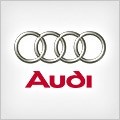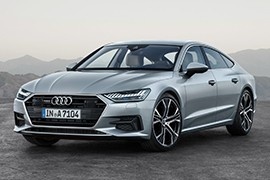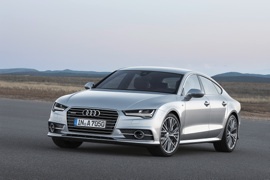
AUDI A7
Generations Timeline, Specs and Pictures

In 2017 Audi changed the first generation of its hatchback-coupe like four-door vehicle, the A7.
The second generation carried over the key elements that made the first one sell in large numbers and made some new modifications for a better look and feel of the vehicle.
Audi tried to make the A7 Sportback look like an athletic sculpture with a long engine hood, long wheelbase and short overhangs. Pronounced contours emphasize the wheels and reference Audi’s genes, which determine the body’s proportions. The A7 is 4969mm (16.3 ft) long, 1908 mm (6.3 ft) wide and 1422 mm (4.7 ft ) high. The wheelbase is quite big, at 2926 mm (9.6 ft).
Inside, there is room for four adults, and the rear headroom is enough, but not vast. The digitalization of Audi interiors started with the A8 and continued in this generation of the A7. The frameless windows were carried over and they do look great in this fastback four-door coupe look.
For propulsion, the 2017 A7 uses a mild-hybrid V6 unit. Based on a 48-volt architecture, with a belt-driven starter-generator (BAS), the 3.0-liter gasoline TFSI (turbo with direct injection) engine offers 350 hp and 500 Nm (368.8 lb-ft) of torque. The power is sent to the all-wheel-drive quattro system via a 7-speed S-Tronic gearbox (Dual-clutch technology) and the performance is up to the A7’s aggressive look. The 0-100 kph (0-62 mph) sprint is done in 5.4 seconds and the maximum speed is limited to 250 kph (155 mph). Additional engines with four cylinders, both gasoline and turbodiesel will follow.

The Audi A7 had a good start in 2009 and, in May 2014, it launched the mid-life cycle refresh for its big, fast-back, four-door coupe.
When the first generation of the Audi 100 was launched, the car-manufacturer didn’t want to build a classic station-wagon so it built a sloped rear-end and named it Avant. But, in the end, it had to build a regular station-wagon to keep the sales up against other premium station-wagons. But Audi returned with the sloped back on the A5 Sportback and the A7.
In 2014, a mid-life refresh was launched. At the front part of the car the most striking changes were for the singleframe grille, bumper and new optional Matrix LED headlights. New, dynamic turn signals were installed at the front. The rear taillights were also redesigned and the dynamic turn signal was standard.
The A7 was built from the beginning without frames for the side windows. Inside the vehicle the dominant element was a horizontal line surrounding the driver and the passenger. The new MMI infotainment unit was standard and an option for head-up display was introduced. With the rear seats up it offered 535 liters (18.9 cu-ft) of space, which could be extended up to 1390 liters (49.1 cu-ft) with the rear seats folded down.
Under the hood, Audi installed the latest Euro 6 engines from its arsenal. It offered a choice of five engines: two gasoline and three diesel units. The power ranged between 218 hp and 333 hp. The old multitronic gearbox was dumped and a new, 7-speed, dual-clutch transmission was installed.

Not a sedan, not a wagon, but a 5-door coupe with the luxury of an Audi 6 and the sportiness of an Audi A5.
A great combination of style and agility.
At the front, the A7 was designed with a large single-frame grille that looked like the one on the A8. The design gets more interesting when looked from the side, with the swept-back roofline that brought the A7 into the coupes world.
The large coupe had nearly 5 meters in length and was rather low as well. To complete the sporty design, the A7 had a retractable rear spoiler that would flip out at cruising speeds.
Extremely versatile, the trunk size of the A7 was at 535 Liters and the backrests could be folded to extend it if necessary.
While the coupe design was impressive, it had to come with a compromise: the headroom available for the passengers in the rear seats was limited.
With the B pillar placed pretty far from the front seat line, the access inside was a bit uneasy. But once inside, everything became classy and comfortable.
High quality materials were used throughout the cabin, with intuitive, easy to use controls.
One of the most appreciated engines mounted on the A7 was the 3.6-liter V6 that developed 245 hp. The A7 reached 100 km/h in around 5.5 seconds.
The standard equipment included 2-zone climate control, a start stop system to reduce fuel consumption, a parking system with a reverse camera and the Audi’s multimedia interface.
Optionally, users could choose a head-up display and ventilated seats.























































